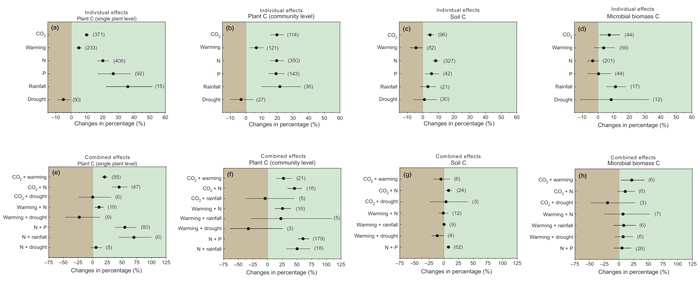| Follow @co2science |
Paper Reviewed
Yue, K., Fornara, D.A., Yang, W., Peng, Y., Peng, C., Liu, Z. and Wu, F. 2017. Influence of multiple global change drivers on terrestrial carbon storage: additive effects are common. Ecology Letters 20: 663-672.
Writing as background for their work, Yue et al. (2017) state that "understanding the interactive effects of multiple global change drivers on terrestrial C storage is crucial for validating Earth system models and for predicting future C storage responses to global changes." Such knowledge is important because it helps scientists evaluate whether positive or negative climate feedbacks will result from future alterations in terrestrial carbon storage. Thus it was the goal of Yue et al. to investigate "how ecosystem C storage might respond to the simultaneous and interacting effects of multiple global change drivers," including elevated atmospheric CO2 (eCO2), a warming of mean annual temperature, N addition, P addition, and increased rainfall and drought. They accomplished this objective by performing a meta-analysis whereby they synthesized the findings of 633 published field manipulative studies representing 3620 data observations. And what did that meta-analysis reveal?
As illustrated in the figure below, the impact of the various global change drivers predominately resulted in (1) an increase in terrestrial C storage, whether analyzed as individual or combined effects. Yue et al. also report that (2) "the magnitude of these effects on plant C pools was seldom scale dependent (i.e. did not vary significantly between single-plant and plant-community levels); (3) soil C and soil microbial biomass C (MBC) pools are much less sensitive to global change than plant C pools; (4) plant C pool responses to the combined effects of multiple two-driver pairs are also seldom scale dependent, whereas soil C and MBC pools still show weaker responses to combined effects of multiple global change drivers and (5) ecosystem type, plant compartment, environmental and experimental factors are all important moderator variables mediating the responses of terrestrial C storage to both individual and combined effects of multiple global change drivers."
While additional work is likely needed to further constrain the magnitude of the C pool responses to these global change drivers, it is encouraging to note the direction of the response, which clearly is positive and indicative of an overall enhancement of the terrestrial C sink. Thus, in the years and decades ahead, it should be expected that the terrestrial biosphere will continue to act as a break on the modern increase in atmospheric CO2, sequestering more and more C in its above- and below-ground pools and acting as a negative feedback to projected CO2-induced global warming.

Figure 1. Individual effects of different global change drivers on (a) plant C pools at the single-plant level, (b) plant C pools at the plant-community level, (c) soil C pools and (d) soil microbial biomass C (MBC) pools, and the combined effects of different global change drivers on (e) plant C pools at the single-plant level, (f) plant C pools at the plant-community level, (g) soil C pools and (h) soil MBC pools. Results are expressed as the percentage change relative to the control (%). Values indicate the means with 95% confident intervals (CIs) and sample size numbers are shown in parentheses. The effects of global change drivers are significant when the 95% CIs does not overlap with zero. Legend: CO2 = elevated CO2; N = nitrogen addition; P = phosphorus addition; Rainfall = increased rainfall. Source: Yue et al. (2017).




